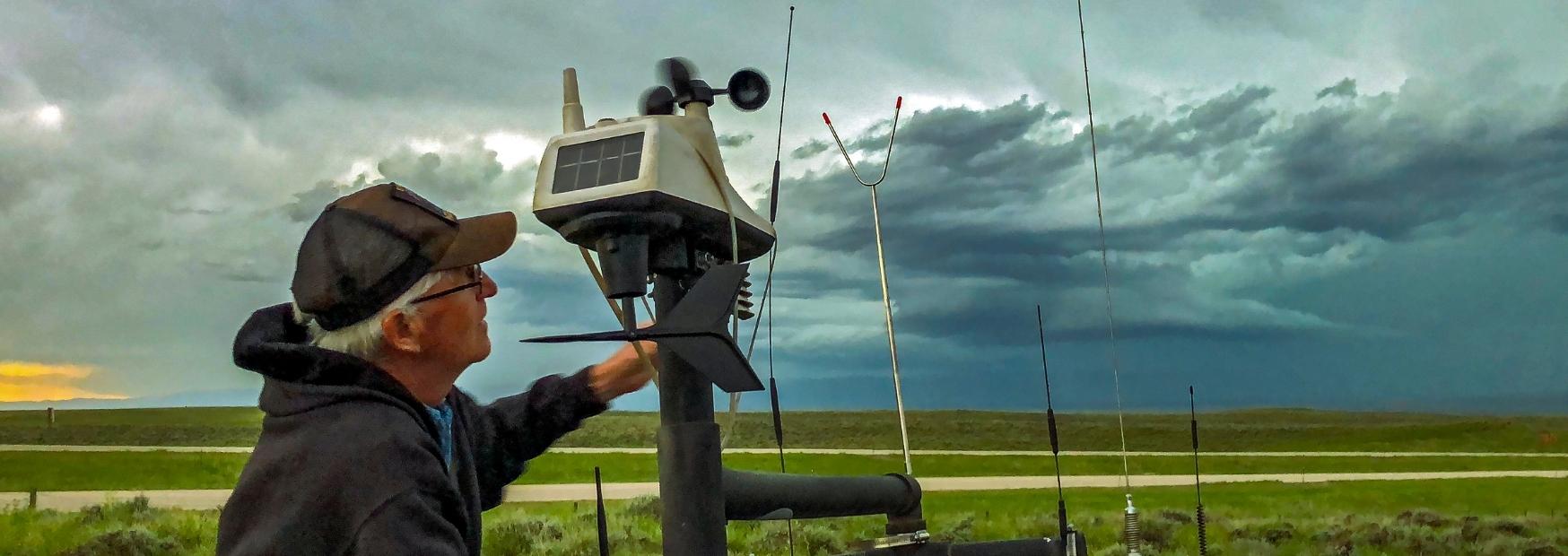
Meteorology, also known as weather watching, is a fascinating field that encompasses the study of the Earth’s atmosphere and its ever-changing weather patterns. From predicting storms to understanding climate change, meteorologists play a vital role in our everyday lives. But did you know that there are some extraordinary facts about meteorology that will leave you in awe? In this article, we will dive into the world of weather and explore 11 astonishing facts that will broaden your understanding of meteorology. From the tallest storm cloud to the world’s largest hailstone, these mind-blowing facts will uncover the hidden wonders of the atmosphere and show you just how remarkable our planet’s weather truly is. So sit back, relax, and prepare to be amazed by these extraordinary meteorological phenomena.
Key Takeaways:
- Meteorologists use complex math to predict weather, while satellites capture Earth’s images every 10-15 minutes, helping us track storms and analyze weather systems in real-time.
- Tornadoes can create winds over 300 mph, and lightning can strike the same place multiple times. These extraordinary meteorological facts showcase the power and wonders of our ever-changing atmosphere.
Weather forecasts depend on complex mathematical models.
In order to predict the weather, meteorologists use sophisticated mathematical models that take into account various atmospheric factors such as temperature, humidity, wind speed, and pressure. These models analyze historical data and current conditions to generate accurate weather forecasts.
Clouds can form at extremely high altitudes.
Did you know that clouds can form even at heights of 80,000 feet or more? These high-altitude clouds, known as noctilucent clouds, are composed of tiny ice crystals, and they are most commonly seen during the summer months in polar regions.
The largest hailstone ever recorded weighed over a pound.
In 2010, a hailstone with a diameter of 8 inches and a weight of 1.93 pounds fell in Vivian, South Dakota, making it the largest hailstone ever recorded. This extraordinary fact showcases the incredible power and intensity of severe thunderstorms.
Weather satellites can capture images of the entire Earth every 10-15 minutes.
Thanks to advanced weather satellites, meteorologists are able to monitor weather patterns and changes in real-time. These satellites orbit the Earth and provide valuable data, allowing forecasters to track storms, monitor cloud cover, and analyze weather systems.
Tornadoes can create winds of over 300 miles per hour.
Tornadoes are one of nature’s most destructive forces, capable of producing winds that exceed 300 miles per hour. These powerful vortexes of rotating air can cause significant damage to structures and pose a serious threat to human safety.
Lightning can strike the same place multiple times.
Contrary to popular belief, lightning can strike the same location more than once. Tall buildings and other structures that serve as lightning rods attract electrical discharges, making them prone to multiple strikes during a single thunderstorm.
Hurricanes are categorized based on wind speed.
Hurricanes are classified into different categories based on their maximum sustained wind speeds. The Saffir-Simpson Hurricane Wind Scale ranges from Category 1 (74-95 mph) to Category 5 (157 mph or higher), indicating the destructive potential of these tropical cyclones.
The El Niño Southern Oscillation affects global weather patterns.
The El Niño Southern Oscillation (ENSO) is a climate pattern that influences weather conditions worldwide. This complex phenomenon occurs in the tropical Pacific Ocean and can lead to changes in sea surface temperatures, which in turn impact rainfall patterns and temperature variations across the globe.
Thunderstorms can produce large hail, heavy rain, and lightning.
Thunderstorms are often associated with intense rainfall, lightning, and occasionally large hail. These dynamic and electrically charged weather events can develop rapidly, bringing both beauty and danger to the skies.
Weather balloons can reach heights of over 100,000 feet.
Weather balloons are integral to meteorological data collection. These large balloons equipped with instruments are launched into the atmosphere and can ascend to altitudes of over 100,000 feet, providing valuable data about temperature, humidity, and atmospheric pressure.
Weather radar can detect precipitation and severe storms.
Weather radar plays a crucial role in monitoring and detecting precipitation, as well as identifying severe storms. Radar systems use electromagnetic waves to measure the intensity and movement of rain, snow, and other forms of precipitation, enabling meteorologists to track weather systems accurately.
Conclusion
In conclusion, meteorology is a fascinating field that allows us to better understand and predict the weather. Through the study of atmospheric conditions, meteorologists can provide valuable information that helps us plan our daily activities, mitigate risks, and protect lives and property. From the importance of air pressure to the impact of greenhouse gases, there is much to learn about the dynamic nature of our atmosphere.By exploring these 11 extraordinary facts about meteorology, we have gained insight into the intricacies and marvels of weather watching. Whether it’s the stunning phenomenon of lightning or the formation of tornadoes, meteorology never ceases to captivate our curiosity. So next time you look up at the sky, take a moment to appreciate the complexity and beauty of the weather systems that surround us.With ongoing advancements in technology and research, the field of meteorology will continue to evolve, empowering us to make informed decisions and adapt to the ever-changing weather patterns. So let’s embrace our fascination with meteorology and continue to marvel at the wonders of the atmosphere that shape our everyday lives.
FAQs
1. What is meteorology?
Meteorology is the scientific study of the Earth’s atmosphere and its phenomena, including weather patterns, climate, and atmospheric conditions.
2. Why is meteorology important?
Meteorology is important because it helps us understand and predict the weather, enabling us to make informed decisions and prepare for various atmospheric events.
3. How do meteorologists predict the weather?
Meteorologists use a combination of weather models, satellite imagery, radar observations, and ground-based instruments to gather data and analyze weather patterns, allowing them to make forecasts and predictions.
4. What is air pressure and how does it affect the weather?
Air pressure is the force exerted by the weight of the atmosphere. It plays a crucial role in determining weather patterns, with areas of high pressure typically associated with fair weather and low-pressure systems often bringing clouds, precipitation, and storms.
5. How are hurricanes formed?
Hurricanes are formed over warm ocean waters when a disturbance, such as a tropical wave or a low-pressure system, interacts with moist air and favorable atmospheric conditions. As warm air rises and cools, the release of energy fuels the storm, leading to its intensification.
6. What causes lightning?
Lightning is caused by the buildup of electrical charges within a thunderstorm cloud. When the electrical charge polarization becomes strong enough, it discharges in the form of a lightning bolt, creating a sudden and intense flash of light.
7. Can meteorologists accurately predict long-term climate change?
While meteorologists can make short-term weather predictions with a reasonable degree of accuracy, long-term climate change is a complex process that involves various natural and human factors. Predictions regarding long-term climate change rely on climate models and ongoing research.
8. How are weather and climate different?
Weather refers to the short-term atmospheric conditions at a specific location, such as temperature, humidity, precipitation, and wind. Climate, on the other hand, refers to the long-term average of these weather patterns in a particular region.
9. What role do greenhouse gases play in the Earth’s climate?
Greenhouse gases, such as carbon dioxide and methane, trap heat in the Earth’s atmosphere, leading to the greenhouse effect. This effect contributes to the warming of the planet, altering weather patterns and causing climate change.
10. How do meteorologists study severe weather phenomena like tornadoes?
Meteorologists study severe weather phenomena like tornadoes through a combination of ground-based observations, remote sensing technologies, and storm-chasing vehicles. These observations help shed light on the formation, structure, and movement of tornadoes, enabling better warning systems and improved understanding.
11. Can meteorology help with disaster preparedness and response?
Yes, meteorology plays a crucial role in disaster preparedness and response. By providing advance warnings for severe weather events, meteorologists help communities take proactive measures to ensure the safety of residents, mitigate damages, and facilitate effective response efforts.
Meteorology offers endless fascination, from complex forecasting models to record-breaking hailstones. Delving deeper into this captivating field, you can explore the lives of renowned meteorologists, gain insights into space-based weather observations, and discover intriguing facts about well-known weather personalities like Rob Marciano. Each facet of meteorology unveils a world of wonder, inviting you to expand your knowledge and appreciate the incredible forces shaping our atmosphere. Embark on a journey through these enthralling topics, as you unravel the mysteries of weather and those who dedicate their lives to understanding it.
Was this page helpful?
Our commitment to delivering trustworthy and engaging content is at the heart of what we do. Each fact on our site is contributed by real users like you, bringing a wealth of diverse insights and information. To ensure the highest standards of accuracy and reliability, our dedicated editors meticulously review each submission. This process guarantees that the facts we share are not only fascinating but also credible. Trust in our commitment to quality and authenticity as you explore and learn with us.


